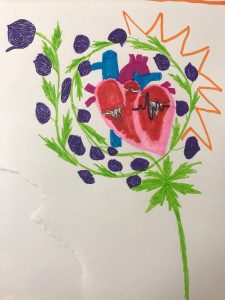Monkshood is a plant that has been used as a both poison and a herbal medicine. I would not recommend using it can be quite deadly. The main component Aconite binds to sodium channels and forces them to stay open. Sodium enters the cell and the channels won’t close. This can either cause your heart to have ventricular fibrillation or cause it to slow down. Either way left untreated leads to heart failure and then death. With my drawing I wanted to show how Monkshood attacks the heart.


This project focuses on objectives 39 and 40: explain how the heart translates an electrical signal to a contraction and explain how the heart is regulated. Monkshood is used for medicinal purposes and as a poison. When applied to skin, the main component of the plant, Aconite, first stimulates and then paralyzes nerves of pain, temperature, and touch. For this reason, the plant has historically been used as an anesthesia, although an overdose can be deadly. Symptoms of an overdose appear rapidly. Monkshood works by blocking sodium channels open and slowing down the heart rate or causing ventricular fibrillation, both of which lead to death if left untreated. The drawing shows how monkshood “strangles†the heart and causes heart failure. Interestingly, the distinct shape of a heart (not in the anatomical sense but the actual shape) can be detected in center of the drawing. This piece is very artistic and colorful and is nonliteral but still informative. The introduction to the piece is a helpful overview explaining the dangerous effects of Monkshood. Good work!